Inside Out is already being hailed as Pixar’s best film in years, and it’s easy to understand why; the idea of delving into someone’s head and parsing out their emotions is a beautiful concept for a film meant to enchant and engage both children and adults. But while viewers were likely ready for something sophisticated—as Pixar’s pedigree comes with a great deal of expectation these days—they might not have been expecting a film that essentially functions as therapy for everyone lucky enough to see it.
(Spoilers for the film below.)
Inside Out focuses on eleven-year-old Riley, who has just been moved by her parents from Minnesota to San Francisco. This sizable change at a point in life when children are just beginning to mature sets off a flurry of chaos on her mind as she begins to confront loss, embarrassment, and pain on levels that she has never had opportunity to experience before. Inside her head are five core emotions; Joy, Sadness, Fear, Disgust, and Anger. (Writers at Pixar talked to psychologists and found that there was one other core emotion—surprise—but opted to leave that out of the film as it was too similar to fear.) They help Riley make her decisions, some of which form Core Memories that result in Islands of Personality, which essentially make Riley up as a person.
Joy, played by an effervescent Amy Poehler (it’s like having a little Leslie Knope in your brain!), has spent every moment of her existence focused on keeping her girl happy. Initially, she understands that most of the emotions play a role in keeping Riley alive; Disgust prevents Riley from getting poisoned, Fear keeps Riley safe from dangers while she navigates the world. Anger’s passion is also easily understood even when it isn’t exactly useful, but Sadness presents a conundrum to Joy, in that she seems to serve no helpful purpose at all.
Their problems start on Riley’s first day at her new school, when she’s asked to introduce herself in front of the class. When Riley calls up her happy life from Minnesota (featuring Core Memories), Sadness touches those memories without meaning to, tinging them with sadness and causing Riley to have a breakdown in class. This moment produces a new Core Memory, the first one to be created in a moment of sorrow. Joy isn’t having it, and the ensuing kerfuffle accidentally lands her and Sadness in one of the tubes that leads to Riley’s Longterm Memory, with her Core Memories in tow; with them both gone from Headquarters, it’s up to Fear, Disgust, and Anger to try and navigate Riley through life with none of those memories there to power her Islands of Personality. Riley is essentially diminishing as she remains disconnected.
Joy and Sadness are forced to work together to find their way back to HQ, meeting Riley’s old imaginary friend Bing Bong on the way. They pass through a few of her Personality Islands in an effort to get back, making it into Dream Productions when she falls asleep and they need to wake her. Back at Headquarters, things have been going horribly wrong, as the influence of Fear, Disgust, and Anger have guided Riley further into her sense of displacement. They eventually give her the idea to run away, back to her home in Minnesota, since Anger believes that’s the only place where she can form good Core Memories. Joy and Bing Bong eventually get lost in the Brain Dump, there to be forgotten permanently, until Bing Bong sacrifices himself to get Joy back to Longterm Memory. Finally understanding the purpose of Sadness, Joy gets them both back to Headquarters before Riley makes it out of San Francisco. She lets Sadness take the lead, giving Riley the ability to tell her parents that their “Happy Girl” isn’t happy here, and getting her the family support she needs to navigate this new situation.
What makes this movie so unique is its deft look at emotional development through Joy’s eyes. The film frames Joy’s difficulty with Sadness as an issue of context; when we’re very young, being sad is rarely a logical thing. We have blogs like Reasons My Son is Crying to prove that. Joy takes issue with Sadness because she can see no purpose behind her role in Riley’s mind—she just seems to muck up perfectly good experiences. The film doesn’t bother to explain why Sadness suddenly has the urge to touch all of Riley’s good memories and tinge them her particular shade of blue. We’re left to extrapolate how emotions evolve in life, how memories that were once dominated by a single overpowering feeling gain complexity, and are suddenly written over with many other powerful emotions. By the end of the film, Riley’s experiences are tinged with the colors of every emotion, indicating her development into a more mature, aware human being.
The film is also remarkable for knowing not to equate sadness with depression as though they are one and the same. In fact, the film is genius in differentiating the two; Joy learns that Sadness is a useful emotion to deploy in life, allowing a deeper connection with others, but depression is a different monster altogether—when Riley gets on the bus to run away to Minnesota, the “console” of her mind (the place where her emotions navigate her responses) goes gray and freezes over. The metaphor for depression is not about feeling sad, but about being numb and caught in a repetition of that numbness.
Sadness’ journey in the film is likely to give a whole generation of children a new way of communicating their stresses. In fact, the message contained in Inside Out is a particularly meaningful one in an age when humanity’s obsession with perpetual happiness might be hindering our development on a large scale. Joy (appropriately like so many parents in this day and age) wants Riley’s every day on Earth to be full of delight, failing to understand that sadness is essential due to its ability to signal others; when we’re sad, others respond by attempting to bolster us. To that effect, sadness is a natural step to finding happiness. But more importantly, the film doesn’t shy away from the idea of working through sadness as a fulfilling experience on its own. When Bing Bong is crying over the loss of the rocket he and Riley built together, Joy attempts to get him going with positive reinforcement, which does nothing. Then Sadness sits beside him and validates his right to feel that pain by allowing him to live with it for a moment, to let his sorrow breathe and sink in. After some time, Bing Bong is capable of righting himself and coming to their aid again. Joy is confused as to why this method worked when hers didn’t, but Sadness is simply doing her job—letting others process the unhappy parts of life.
Bing Bong’s role in the film, and his eventual sacrifice also hit hard in this glimpse of the working mind. He helps Joy and Sadness out of a desire to come out of retirement, to reunite with Riley’s consciousness and go on more adventures. But his decision to save Joy at the expense of his own existence (he stays in the Brain Dump to be permanently forgotten) tells a far more poignant tale; that imaginary friends—and imagination altogether—are forms of protection, and that they continue to fulfill that role, even if we’re not consciously calling on their help.
Because we can witness Riley’s experiences in the film, Inside Out works on micro and macro levels. While we watch Joy learn to appreciate the purpose of Sadness, we also watch Riley’s parents learn a valuable lesson; their Happy Girl can’t always be happy just because they need or want her to be. As she becomes a more intricate, nuanced person, they’re going to have to look harder for signs of distress. The film is explicit in its acknowledgment of family as a part of emotional development, but it does so without being preachy or cloying on the subject. People are shaped by relationships with other people; the stronger those bonds are, the easier it is to grow.
The film is also dizzyingly funny, from it’s analysis of our more base emotions to explanations for why you sometimes just can’t get a song out of your head, and all of that works together to make a truly delightful piece of cinema. I have some questions that were never quite answered to my satisfaction—for example, I’m curious as to why Riley seems to have a mix of genders for the emotions in her head, while all the adult seem to have emotions of the same gender; is this just dependent on the person, or is the suggestion that we become more gendered in our thinking as we age? Either answer would be an interesting one. All this really demands are more viewings of the film, which is layered enough to demand second and third and fourth looks.
But in the end, what sets this movie apart is its ability to thoroughly educate its audience via entertainment. After seeing Inside Out, the rest of my day was kind of rough, and my wife glanced over to my corner of the couch that evening and said, “Sadness is pushing all the buttons in your brain today, huh?” And I realized just how useful this movie will be to generations of viewers. It can give so many people a clear and simple vocabulary to deal with their emotions. It has all the benefits of good therapy packed into an adventure that tours the inside of a little girl’s mind. If you do yourself no other favors this summer, go see it. You deserve that catharsis too.
Emmet Asher-Perrin will be in the corner crying over her imaginary friends. You can bug her on Twitter and Tumblr, and read more of her work here and elsewhere.










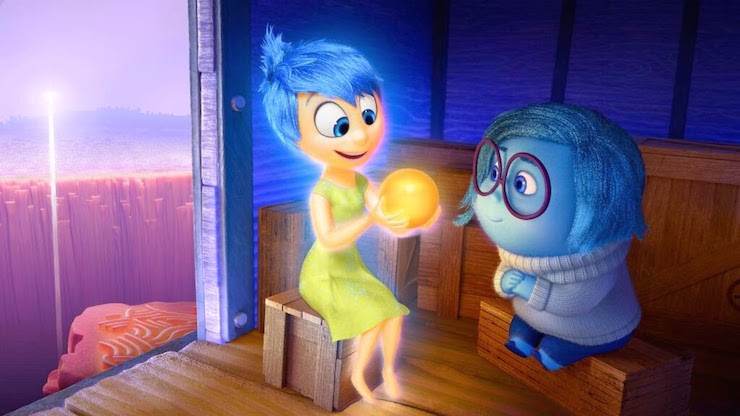
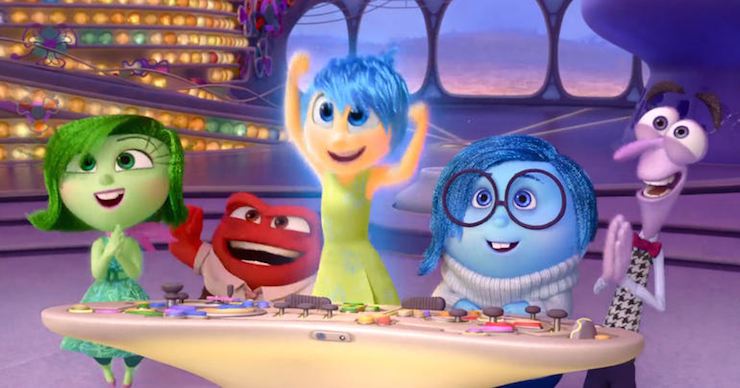
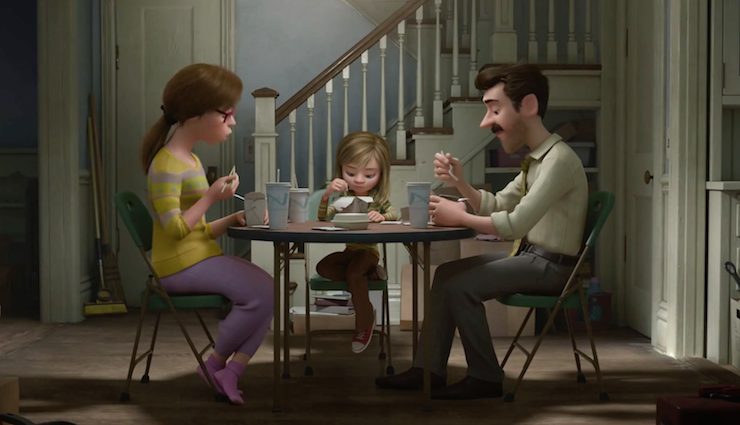
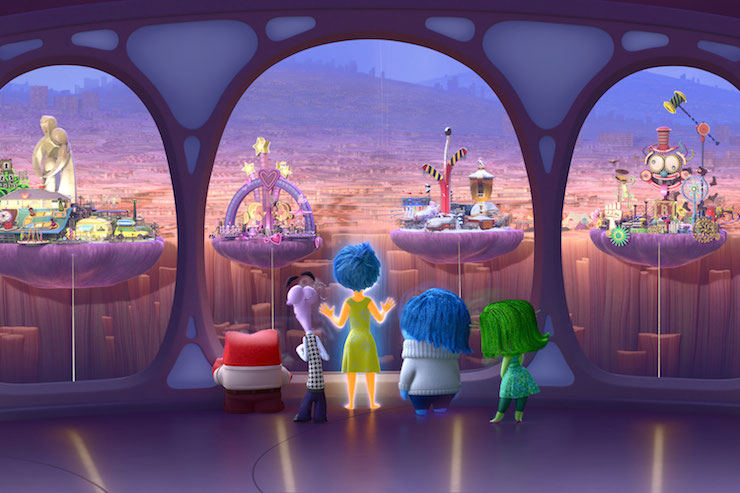
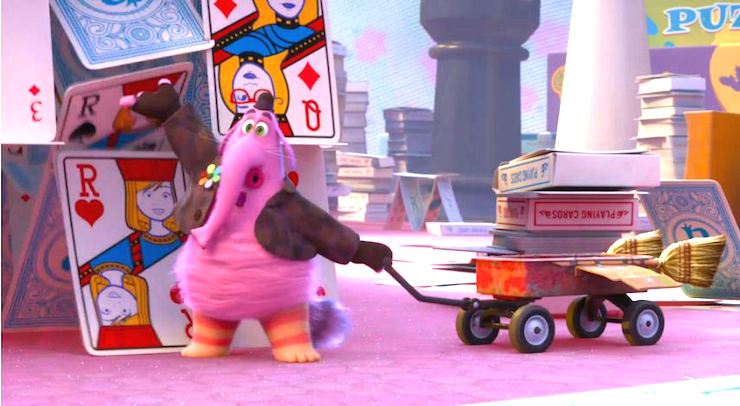
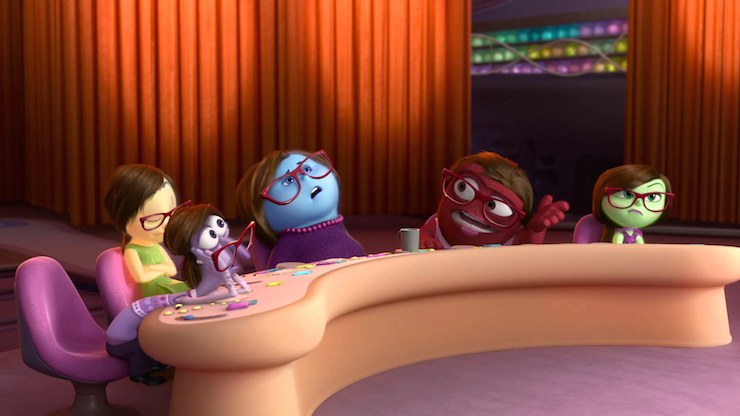
I found myself not really liking this movie as much as I’d hoped to. It wasn’t until about an hour in that I really started to get engaged. Before then Joy and Sadness just seemed to bounce around randomly. A few thoughts on your post though.
I’d assumed Sadness’s new ability to taint happy memories was simply because those memories were no longer entirely happy – although that seems a bit recursive if thought about too long.
I also figured the mix of genders in her head was a matter of her identity not being fully formed yet, or something along those lines. I have to wonder at what point an emotion changes gender, and if it’s a surprise for them and the other emotions when it happens!
And why is the primary emotion for the mother sadness? Sheesh!
I think Riley’s mix of emotions is just to provide characters of both gender in the story, probably out of a fear boys wouldn’t want to watch a movie about a girl and girl emotions. Don’t like being the cynic, but there it is; every other character’s emotions who we see (Riley’s parents, the pizza girl, the boy who bumps into her, the teacher, the cool girl, the bus driver, the clown…) have mono-gendered emotions.
As for why Riley’s mom is headed by sadness, I think it’s a matter of context. As an adult with a much fuller emotional spectrum, her Joy doesn’t need to rule over the brain any longer. In this case, they’ve recently moved, Riley is concerned about their new home, their moving van is bullshit, and Riley’s dad is clearly having problems settling into San Fransisco, so Mom’s Sadness (and thus, Worry in particular) is taking leadership to try to smooth things over. Likewise, Dad’s Anger and Fear seem to be currently #1 and #2 in his head, probably because of the stress of his job and the move.
Amusingly, we can also see that the cool girl’s Fear, not Disgust, is in the driver’s seat, which is pretty understandable for being a preteen girl who is trying to fit into a scene.
Thanks for the analysis; it does a good job of highlighting something I encountered in the days after I saw it.
I was initially disappointed in the movie because (ironically?) I didn’t get the emotional connection I was looking for; I could intellectually appreciate the tour of the inner mind, but it didn’t really engage me in the way that (for example) the Ellie and Carl married life sequence did in Up. The scenes exploring Riley’s interior landscape were interesting without really being engaging; the characters’ plight didn’t really move me, the travel from place to place didn’t feel like it had a direction or theme, and I didn’t feel the sensawonder that some of the reviews described.
But in the days after, I’ve noticed myself thinking a lot in the terms and metaphors used by the movie – so it’s gotten inside my head a lot more than I’d thought. It’s shifted my worldview, and that’s a sign of a good movie. As you say, it’s given (or at least reinforced) a new language to discuss events.
Very nice review.
Actually, what came to my mind was that the character named “Sadness” wasn’t really a pure sadness. It was actually “Empathy”. When the character dealt with Bingbong, that was empathy. Communicating more complex emotions with her family is facilitating empathy.
And thus, the primary character at the helm in Mom’s brain is Empathy — seems to fit.
All that being said, that’s a much more complex name/emotion/skill to navigate so perhaps they simply went with “Sadness” to make it all more accessible.
What I liked most about the movie was not the plot, but – as the post notes – the new vocabulary for discussing emotions. I can see child psychologists showing this to their patients and then using the language of the film to talk about their feelings.
I don’t usually leave comments on stuff but I wanted to say a few things: right on to the lady correctly observing sadness as empathy and empathy as a great communication tool. Because it is. When one responds with empathy, judgement is reserved, so one becomes more ‘in tune’ to other people. There is such a thing as emotional intelligence and empathy is the key for unlocking that door. It was irksome to read the gentleman’s comment on Sadness being in charge of mom’s head, because where’s the sheesh on Anger and Fear ruling Dad’s head??? I also don’t feel like Pixar purposely made Anger and Fear male to “keep little boys engaged in the film” – Pixar is truly above such nonsense, they are legitimate artists! Besides how many decades have little girls, and grown women, dealt with The Smurfette Syndrome (where only ONE female character exists among an entire group of males, or you could look at the barrage of male super hero films – females don’t identify with this nonsense because it’s not a complex story line and IT DOESN’T INCLUDE THEM!)–Inside Outside is a complex plot. I also remember the bus driver who had Anger as all the emotions. Is Pixar commenting that emotions at their pith are actually gender neutral and that females are just as capable of feeling Anger and males are just as capable as feeling Joy or Sadness?–I’d like to think yes. I’d like to think the new gender fluidity will help create a more genuine humanity, gender engineering is real and mainly done to us by corporations, think of why that could be?–control. They’ve been churning out soldiers and shoppers for years, but we’re people, with unique thoughts and emotions. Gender shouldn’t be used to define our core, our core defines our gender. Hopefully we’ll be more empathetic humans to each other as a result.
Saw it this weekend. Great movie, that gave me lots to think about, while being lots of fun along the way. It had a very strong message that we can’t always be happy all the time, and that is OK. It is balance that keeps us strong.
The voice cast was great, the visuals interesting and consistent, and the characters well designed. And it felt very consistent with what we know about human behavior, which gave it credibility and depth.
Interestingly enough, in this movie the message worked without feeling preachy, where the other recent Disney offering, Tomorrowland, also had a strong message about optimism, but ended up feeling very preachy. I wonder how the vetting process for the two movies differed, because it is obvious that Tomorrowland would have benefited from some thoughtful revisions along the way.
I just saw the movie late last night and I really loved it. I especially like what you have to say about sadness and depression — when I was watching, I had made a connection between Riley’s empty emotional state and depression, but I hadn’t made the visual connection about the graying of the control terminal reinforcing it and, frankly, it makes me happy to have that connection made.
I just felt that it dealt with a lot of development in complex and satisfying ways. I was particularly fond of the way that family, honesty, friendship, hockey, and goofball aren’t islands that grow or morph, but that a natural part of Riley’s development actually requires that they actually get destroyed and replaced. This felt like a really true reflection of the rocky, disruptive breakdown and buildup of personalities that happens during development. In fact, now that I think about it, the movie has a motif about how it’s necessary to actually lose certain parts of yourself in order to gain new ones. We see the memory cleaners getting rid of faded memories to make room for new ones. Bing Bong has to go away for Joy to return. Old family island has to be destroyed for new family island to develop. It’s really great, and particularly because it’s not the easy answer. It’s painful to lose goofball and honesty and family and friendship.
I also, coincidentally, had some feelings about the gender question (several hundred words worth, as it turned out). I hope it’s not too spammy to do that, and if it is I’ll happily save you the link click (or just take a comment deletion) if you want and just give you the short version: Riley Anderson is gender fluid, and that’s awesome. That said, it’s not remotely clear to me that Pixar intended her to be gender fluid, and that is not awesome. ymmv with the text vs. intent debate.
Oh Bing Bong… (;_;)
Damn you, Pixar!